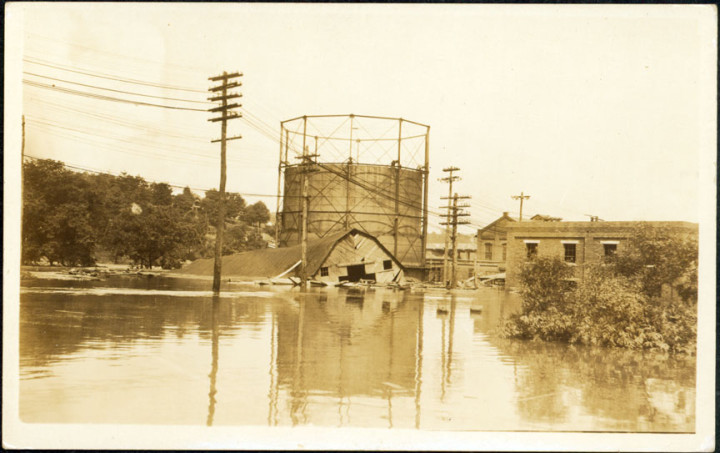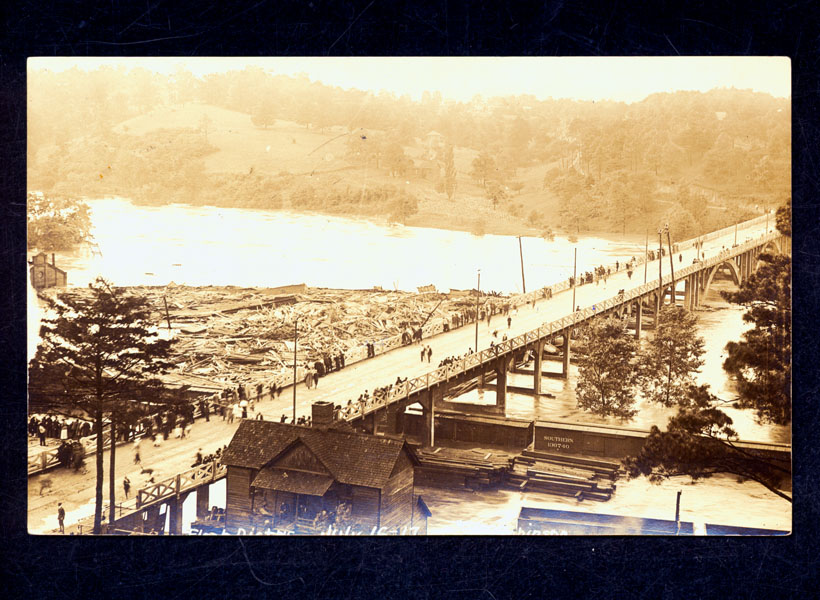With the recent rains and flooding from Alberto, we’ve decided to look back on the Flood of 1916. According to the National Oceanic and Atmospheric Administration, more than 10 inches of rain fell over the upper portion of the French Broad River watershed on July 16, 1916. In Asheville, six people perished that day (with 80 overall deaths in the region). Along with lost lives, the city’s papers estimated property damage at $1 million to $3 million ($23.2 million to $69.6 million in today’s dollar).
On July 17, 1916, powered by gasoline generators, The Asheville Citizen reported:
“Last night Asheville was as a city of the dead. The floods from the heavens ceased to descend, but the city was a city of utter and complete darkness. Here and there a candle or a kerosene lamp cast but feeble rays into complete darkness. The streets were almost deserted, and a sense of fear entered many a heart unaccustomed to new and strange conditions.”
Initial fears, however, subsided. The community would quickly unite in its efforts to help rebuild and find temporary housing for those who lost their homes. Yet amid this goodwill, a battle brewed between some residents and local news publications.
On July 18, two days after the deluge, The Asheville Citizen censured such criticism, stating:
“While The Citizen is receiving much gratuitous advice, despite the adverse conditions under which it strives to give the community a newspaper during these days of disaster, it does not at all appreciate the intimation launched in various quarters to the effect that the newspapers of Asheville are exaggerating flood conditions and giving the outside world an erroneous impression of the existing situation. Nothing could be farther from the truth.”
In a continued effort to refute these claims, The Asheville Citizen solicited copies of newspapers from around the country. It reviewed 17 such publications in its July 22 edition, featuring papers from New York, Kentucky, Georgia, Louisiana, Florida, Virginia, Alabama, Tennessee and Texas. The Asheville Citizen noted: “The accounts of the flood in these papers are interesting more on account of their conservative tone than for any particular news feature.”

Of course, there were exceptions. The article reported that The Atlanta Georgian included “a somewhat garbled account … more concerned with mentioning Atlanta society people supposed to be here.” Meanwhile, The Birmingham Ledger featured a headline that proclaimed, “7,000 were drowned in North Carolina flood.” (The Asheville Citizen made it a point to note that the Alabama paper “did not get the story from Asheville.”) On the other side of the spectrum, The Galveston News “dismissed the flood at Asheville with a few lines.”
Near the end of the assessment, The Asheville Citizen proclaimed:
“Many other papers could be named, but enough has been shown to convince the average Ashevilleian that most of the alarmist talk was done on the streets of Asheville by individuals who had not had the opportunity to see any outside paper. This talk was indulged in before any mail trains had reached Asheville with papers from other points. Those responsible seemed to forget the fact that the Asheville newspapers had as much at stake as any, and more than the average individual in this city. They had business interests of their own to protect, and as well as their own original investments, which they could hardly wish to destroy or injure by circulating reports detrimental to the city.”
In the same day’s paper, The Asheville Citizen ran a statement from its competitor, Asheville Times. The Times emphasized its own conservative reporting, stating it had been “exceedingly careful in the estimates sent to the outer world through the medium of the Associated Press.”
At the end of its statement, the Asheville Times declared:
“A real newspaper man is imbued above all else with the importance of accuracy. For The Times and for our esteemed morning contemporary, The Citizen, we claim this attribute and appeal to our readers to stand with us always for the truth, nothing but the truth and as nearly the whole truth as human endeavor can gather it and well trained reporters and editors can spread it upon the pages of the daily papers.”
Editor’s note: Peculiarities of spelling and punctuation are preserved from the original documents.




One interesting point to note – there is still one survivor of the 1916 Flood on the River – the old Railway Bridge from the Asheville rail yard to points west and north, is still there – it was started in 1906 and finished in 1910 – I think it is the only bridge over the French Broad (railway or otherwise) still around from the time of the Flood. At least in the Asheville area… https://www.facebook.com/photo.php?fbid=10156372798284720&set=a.10151106406474720.448762.501594719&type=3&theater
Thanks for sharing, Phillip. Hope you’re doing well.
Actually the photograph is courtesy of Mr. Gerald Ledford, a local historian and railroad enthusiast – who points out that, with the Ridgecrest to Old Fort section damaged by washouts, this route across the old bridge is the only rail route in and out of Asheville right now. Mr. Ledford has co-written/edited a series of books “If Rails Could Talk” with Mr. Ronald Sullivan – so far there are 4 volumes.
I am doing well, thanks – about to burn up – it is 106F today here at Ft Bliss (El Paso) Texas….we have had one good day of rain since President’s Day!
I used to give speeches on the need for flood insurance in other than coastal areas. This flood was the centerpiece of that speech. As a result of this flood which really hit Altapass the hardest held the national 24 hour rainfall record until something like 1975. More people lost their lives as a result of this event than during Hurricane Flood . It was a flood of biblical proportions.